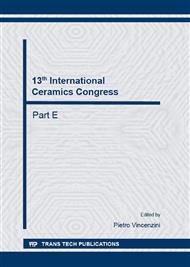[1]
N. Saito, S. -Y. Nishimura, M. Kawano, S. -I. Araki, S. Sukenaga, K. Nakashima, T. Yasukouchi, Fabrication of Nitrogen-Containing Cordierite Ceramics, J. Am. Ceram. Soc. 93 (2010) 2257–2263.
DOI: 10.1111/j.1551-2916.2010.03736.x
Google Scholar
[2]
G. Merkel, D. Beall, D. Hickman, M. Vernacotola, Effects of Microstructure and Cell Geometry on Performance of Cordierite Diesel Particulate Filters, SAE Technical Paper 2001-01-0193 (2001).
DOI: 10.4271/2001-01-0193
Google Scholar
[3]
Y. Onel, A. Lange, A. Staude, K. Ehrig, A. Kupsch, M.P. Hentschel, T. Wolk, B.R. Müller, G. Bruno, Evaluating porosity in cordierite diesel particulate filter materials. Part 2- Statistical analysis of Computed Tomography Data, J. Ceram. Sci. Tech. 5 (2013).
DOI: 10.4028/www.scientific.net/ast.91.64
Google Scholar
[4]
G. Bruno, S. Vogel, Calculation of the Average Coefficient of Thermal Expansion in Oriented Cordierite Polycrystals, J. Am. Ceram. Soc. 91 (2008) 2646-2652.
DOI: 10.1111/j.1551-2916.2008.02485.x
Google Scholar
[5]
W.D. Kingery, Factor affecting thermal stress resistance of ceramic materials. J. Amer. Ceram. Soc. 38 (1955) 3-15.
Google Scholar
[6]
W.P. Addiego, I.M. Melscoet-Chauvel, US Patent 2007/0142208 A1 (2007).
Google Scholar
[7]
G. Bruno, A.M. Efremov, A.N. Levandovsky, B. Clausen, Connecting the macro and microscopic strain response in porous ceramics: modeling and experimental validation. J. Mater. Sci. 46 (2011) 161-173.
DOI: 10.1007/s10853-010-4899-0
Google Scholar
[8]
A.M. Efremov, G, Bruno, Modeling the impact of microcracking on the thermoelasticity of porous and microcracked ceramics, Phil. Mag. 93 (2013) 691-717.
DOI: 10.1080/14786435.2012.729867
Google Scholar
[9]
G. Tzschichholz, G. Steinborn, M.P. Hentschel, A. Lange, P. Klobes, Characterisation of porous titania yttrium oxide compounds by mercury intrusion porosimetry and X-ray refractometry. J. Porous Mat. 18 (2011) 83-88.
DOI: 10.1007/s10934-010-9358-4
Google Scholar
[10]
T. Gordon, A. Shyam, E. Lara-Curzio, The relationship between microstructure and fracture toughness for fibrous materials of diesel particulate filters. J. Amer. Ceram. Soc. 93 (2010) 1120-1126.
DOI: 10.1111/j.1551-2916.2009.03524.x
Google Scholar
[11]
L. Andersson, P.T. Larsson, L. Wågberg, L. Bergström, Evaluating Pore Space in Macroporous Ceramics with Water-Based Porosimetry, J. Am. Ceram. Soc. 96 (2013) 1916-(1922).
DOI: 10.1111/jace.12223
Google Scholar
[12]
F. Zhao, H.R. Landis, S.J. Skerlos, Modeling of porous filter permeability via image-based stochastic reconstruction of spatial porosity correlations. Environ. Sci. Tech. 39 (2006) 239-247.
DOI: 10.1021/es035228b
Google Scholar
[13]
G. Bruno, A.M. Efremov, B. Clausen, A.M. Balagurov, V.N. Simkin, B.R. Wheaton, J.E. Webb, D.W. Brown, On the Stress-Free Lattice Expansion of Porous Cordierite, Acta Mater. 58 (2010) 1994–(2003).
DOI: 10.1016/j.actamat.2009.11.042
Google Scholar
[14]
B.R. Müller, A. Lange, M. Harwardt, M.P. Hentschel, B. Illerhaus, J. Goebbels, J. Bamberg, F. Heutling, Refraction computed tomography. MP Mater. Test. 46 (2004) 314-319.
DOI: 10.3139/120.100592
Google Scholar
[15]
A. Rack, S. Zabler, B.R. Müller, H. Riesemeier, G. Weidemann, A. Lange, J. Goebbels, M.P. Hentschel, W. Görner, High resolution synchrotron-based radiography and tomography using hard X-rays at the BAMline (BESSY II). Nucl. Instrum. Meth. A586 (2008).
DOI: 10.1016/j.nima.2007.11.020
Google Scholar
[16]
D. Chapman, W. Thomlinson, R.E. Johnston, D. Washburn, E. Pisano, N. Gmür, Z. Zhong, R. Menk, F. Arfelli, D. Sayers, Diffraction enhanced x-ray imaging. Phys. Med. Biol. 42 (1997) 2015-(2025).
DOI: 10.1088/0031-9155/42/11/001
Google Scholar
[17]
A. Kupsch, A. Lange, M.P. Hentschel, Y. Onel, T. Wolk, A. Staude, K. Ehrig, B.R. Müller, G. Bruno, Evaluating Porosity in Cordierite Diesel Particulate Filter Materials, Part 1 X-Ray Refraction. J. Ceram. Sci. Tech. 4 (2013) 169-176.
DOI: 10.4028/www.scientific.net/ast.91.64
Google Scholar
[18]
G. Bruno, A.M. Efremov, C.P. An, B.R. Wheaton, D.J. Hughes, Connecting the macro and microscopic strain response in porous ceramics. Part II- Microcracking, J. Mater. Sci. 47 (2012) 3674-3689.
DOI: 10.1007/s10853-011-6216-y
Google Scholar


